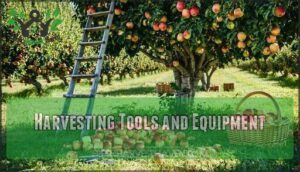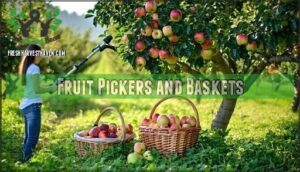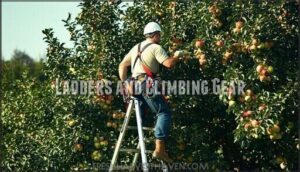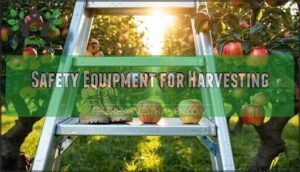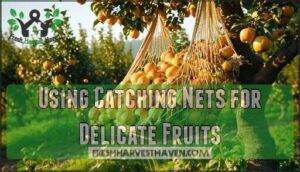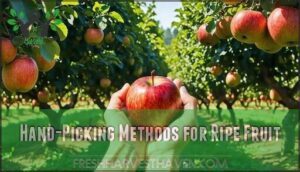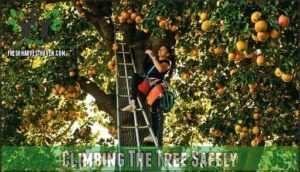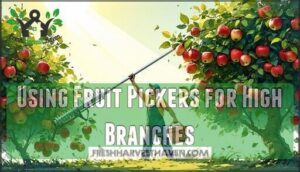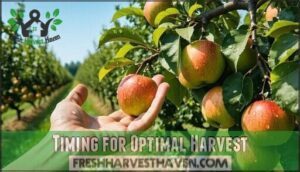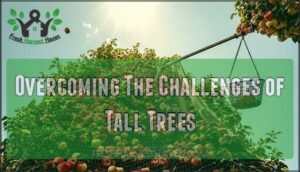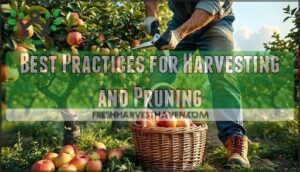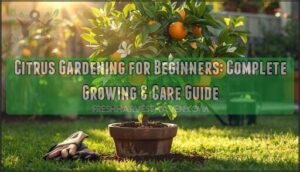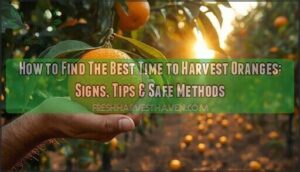This site is supported by our readers. We may earn a commission, at no cost to you, if you purchase through links.
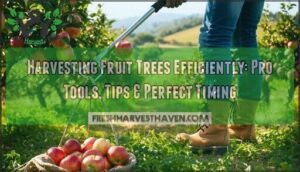 Harvesting fruit trees efficiently starts with timing—you’ll know fruit’s ready when it comes off easily with a gentle twist.
Harvesting fruit trees efficiently starts with timing—you’ll know fruit’s ready when it comes off easily with a gentle twist.
Use telescoping fruit pickers for high branches instead of risky ladder climbing.
Shake-and-catch methods work great for apples and pears, but handle delicate fruits like peaches by hand.
Pick in the cool morning hours to preserve freshness and prevent bruising. Don’t wait for every piece to ripen simultaneously—make multiple passes through your trees.
A catching net saves your back and protects fruit from ground damage. The right tools make all the difference between a frustrating harvest and filling your baskets with perfect, unblemished fruit.
Table Of Contents
- Key Takeaways
- Choosing The Right Fruit Tree
- Essential Tools for Fruit Harvesting
- Techniques for Harvesting Fruit
- Timing for Optimal Harvest
- Overcoming The Challenges of Tall Trees
- Best Practices for Harvesting and Pruning
- Frequently Asked Questions (FAQs)
- How do you harvest a fruit tree?
- Can you harvest fruit from tall trees?
- What are some ladder-less fruit harvesting techniques?
- What tools do you need to harvest and store fruit?
- What are the best practices for harvesting and storing fruit?
- What are the different methods of harvesting fruit?
- How to pick fruit high up on trees?
- What fruit takes the longest to harvest?
- How do you increase the yield of a fruit tree?
- Should you pick the first fruit of a tree?
- Conclusion
Key Takeaways
- Master the timing and gentle technique – You’ll know the fruit’s ready when it comes off easily with a gentle twist, and you should pick during cool morning hours to prevent bruising and preserve freshness.
- Invest in the right tools for safety and efficiency – You’ll need telescoping fruit pickers for high branches, padded baskets to prevent damage, and proper safety equipment like stable ladders instead of risky climbing.
- Use strategic methods for different fruit types – You can employ shake-and-catch techniques for sturdy fruits like apples, but you’ll need gentle hand-picking for delicate fruits like peaches to avoid damage.
- Plan for multiple harvests throughout the season – You shouldn’t wait for every piece to ripen simultaneously; instead, make several passes through your trees to maximize quality and reduce waste.
Choosing The Right Fruit Tree
You can’t harvest efficiently if you don’t start with the right tree for your specific growing conditions, climate zone, and harvesting goals.
Pick varieties that match your soil type, sunlight exposure, and local frost patterns, because a well-matched tree will produce more fruit and stay at a manageable height for easier picking, which is crucial for easier picking.
Common Fruit Tree Varieties
The right fruit tree varieties can make or break your harvesting experience.
When you’re planning your orchard, consider these top performers that’ll deliver consistent yields:
- Apple Varieties – Honeycrisp and Gala offer excellent disease resistance and sweet-tart flavors perfect for fresh eating
- Cherry Types – Sweet Bing and tart Montmorency provide versatile options for different taste preferences
- Peach Cultivars – Freestone varieties like Elberta make fruit harvesting efficiency much easier than clingstone types
Choose fruit trees that match your climate zone for ideal fruit harvesting techniques and long-term success.
You might even consider adding versatile lime trees to your collection.
Ideal Growing Conditions for Fruit Trees
Once you’ve picked your fruit tree varieties, creating the perfect growing environment becomes your next mission.
Your trees crave 6-8 hours of daily sunlight exposure – think of it as their daily vitamin dose.
Sunlight feeds your fruit trees like vitamins feed your body—both need their daily dose to thrive.
Climate factors like frost tolerance and proper spacing set the foundation for both healthy growth and easier harvesting down the road.
Water quality matters more than you’d expect, especially for young trees during their first year.
Match your selections to your USDA hardiness zone, and your fruit trees will thrive like they’ve found their forever home.
Soil and Sunlight Requirements
Getting your fruit trees settled in the right spot makes all the difference between a bumper crop and disappointment.
Your soil composition needs to drain well—nobody likes wet feet, including trees. Most fruit trees thrive in slightly acidic soil with pH levels between 6.0-7.0.
Here’s what you’ll need to nail:
- Sunlight exposure: Give your trees 6-8 hours of direct sun daily for proper fruit development
- Nutrient balance: Well-draining loamy soil rich in organic matter supports healthy root systems
Watering and Temperature Needs
Watering frequency makes or breaks your fruit harvest dreams.
Young saplings need weekly deep soaking to establish strong roots, while mature trees thrive with deeper, less frequent irrigation.
Your irrigation methods matter—drip systems deliver consistent moisture without wasteful runoff, boosting fruit yield substantially.
Young trees thirst for weekly deep soaks, while mature ones sip less frequently, flourishing with deep, deliberate irrigation.
Smart pruning transforms towering challenges into manageable harvests, turning your backyard into an accessible orchard paradise.
Temperature impact on fruit development can’t be ignored.
Frost protection becomes vital for tender varieties—use row covers or select climate adaptation species suited to your area’s conditions.
Smart gardeners create microclimate zones using mulch for temperature regulation and proper tree spacing for airflow.
Understanding your fruit trees’ watering needs paired with smart climate adaptation techniques isn’t just good care—it’s your secret weapon for maximizing next season’s harvesting success and doubling yields.
Essential Tools for Fruit Harvesting
The right tools transform fruit harvesting from a frustrating struggle into an efficient, enjoyable task that saves your back and protects your precious harvest.
You’ll need telescoping fruit pickers, padded baskets, sturdy ladders, and quality pruning shears to reach every branch safely while keeping your fruit bruise-free.
Harvesting Tools and Equipment
Once you’ve chosen your perfect fruit tree, smart harvesting equipment transforms backbreaking work into streamlined efficiency.
Your fruit picking tools arsenal should include:
- Fruit picker poles with telescoping reach for high branches
- Premium pruning shears ensuring clean cuts without bark damage
- Padded collection baskets preventing bruising during transport
- Specialized ladders with wide bases for orchard stability
- Ergonomic tooling like harness bags reducing physical strain
Proper tool maintenance and equipment storage extend your investment’s lifespan.
Consider using wicker baskets for gathering your harvest.
Quality fruit harvesting equipment pays dividends through increased yields and fruit preservation during collection.
Fruit Pickers and Baskets
Selecting quality fruit pickers and baskets makes your harvesting sessions smoother and more productive. Choose tools with ergonomic design features that reduce hand fatigue during long picking days. Look for lightweight picking buckets with soft basket material that won’t bruise your harvest.
| Feature | Poor Choice | Smart Choice |
|---|---|---|
| Basket Material | Hard plastic | Soft-lined canvas |
| Picker Length | Fixed short pole | Telescoping extension |
| Fruit Capacity | Tiny containers | Generous baskets |
| Cleaning Methods | Complex parts | Simple rinse design |
Cleaning methods stay simple—rinse and dry thoroughly after each fruit harvesting session. Consider how weather impacts ripening when planning your harvest.
Ladders and Climbing Gear
While fruit pickers extend your reach, proper ladders and climbing gear let you tackle those towering branches safely.
Platform ladders offer stable footing, while orchard scaffolding provides mobile access across multiple trees.
Climbing harnesses aren’t just for rock climbers—they’re lifesavers when you’re twenty feet up in a cherry tree.
Consider purchasing fruit harvesting ladders to guarantee safety.
Your gear inspection routine should include:
- Check ladder joints and locks for wear or damage
- Inspect climbing harnesses for frayed straps or broken buckles
- Test platform stability before adding your full weight.
Ladder safety starts with choosing outdoor-rated equipment that handles uneven ground.
Remember: fruit harvesting safety isn’t negotiable—one slip can end your season permanently.
Safety Equipment for Harvesting
Beyond the thrill of picking fresh fruit lies a sobering reality: harvesting accidents happen fast. Ladder safety starts with choosing stable, wide-based models that won’t tip under pressure. Always maintain three points of contact when climbing, and never overreach—move the ladder instead.
Eye protection shields you from flying debris and sharp branches that can cause serious injury. Glove selection matters too: leather protective gloves handle thorny trees, while rubber grips work best on wet surfaces.
For tall trees, harness systems aren’t optional—they’re lifesavers. A quality climbing gear setup includes both chest and leg straps for maximum security. Don’t forget head protection when working under heavy branches.
Your safety gear investment pays dividends. Quality ladders with cushioned grips and telescoping handles keep you stable and comfortable. Remember, the sweetest fruit isn’t worth a trip to the emergency room—proper fruit harvesting safety guarantees you’ll enjoy many seasons ahead.
Techniques for Harvesting Fruit
You’ll need different techniques depending on your fruit type and tree height, from gentle hand-picking for soft peaches to using telescoping pickers for high apple branches.
Mastering these methods means you’ll protect your fruit from bruising while maximizing your harvest, whether you’re dealing with delicate berries or sturdy citrus, and this is crucial for harvest.
Using Catching Nets for Delicate Fruits
Catching nets transform delicate fruit harvesting from a bruising nightmare into smooth sailing. These specialized tools prevent fruit damage while boosting your harvest efficiency.
Net Material varies by fruit type – citrus nets handle heavier loads, while grape nets use fine mesh for Fruit Protection. Quality Net Durability means your investment pays off season after season.
Placement Techniques make the difference:
- Position nets directly under fruiting branches before shaking
- Secure corners with stakes to prevent shifting during collection
- Use gentle handling when transferring caught fruit to baskets
- Move nets systematically for complete tree coverage
- Check for proper mesh tension to avoid fruit bruising
Smart Cost Analysis shows nets quickly pay for themselves through reduced waste. To maintain the quality of harvested berries, consider rapid cooling methods post-harvest.
Hand-Picking Methods for Ripe Fruit
Master handpicking by using gentle twisting motions that release fruit cleanly from branches. This technique prevents damage to both your harvest and the tree itself.
Check for optimal ripeness by looking for bright colors and slight softness. Cool morning temperatures make fruit handling easier and reduce stress on your produce.
Keep harvest containers within arm’s reach to avoid unnecessary movement. Minimizing bruising starts with proper positioning and smooth movements throughout your fruit tree harvesting process.
| Fruit Type | Picking Technique |
|---|---|
| Apples | Lift and twist upward |
| Peaches | Cup gently, twist slightly |
| Pears | Support base, twist counterclockwise |
| Plums | Pinch stem, pull straight |
| Cherries | Grasp stem, pull quickly |
Focus on ladder safety by maintaining three-point contact and staying within comfortable reach.
Climbing The Tree Safely
Sometimes you’ll need to climb for those perfect fruits hanging just out of reach. Your safety gear and proper footwear are your best friends here—think of them as your fruit-picking insurance policy.
Before ascending, follow these safety precautions:
- Check tree stability and weather conditions thoroughly
- Secure climbing gear including harness systems properly
- Maintain three points of contact always
- Plan your descent route before going up
Ladders beat risky branches every time.
Using Fruit Pickers for High Branches
When climbing isn’t practical, fruit pickers become your harvesting heroes.
These telescoping poles extend 8-20 feet, putting those high branches within easy reach. Different picker head types handle various fruits—basket heads cradle apples gently, while claw designs grip citrus perfectly.
| Picker Head Type | Best For | Key Feature |
|---|---|---|
| Basket Head | Apples, Pears | Cushioned collection |
| Claw Design | Citrus, Stone Fruits | Secure grip |
| Bag Attachment | Small Fruits | Multiple collection |
Choose lightweight models with comfortable grips. Proper maintenance keeps your harvesting tools working smoothly for years of productive picking.
Timing for Optimal Harvest
Knowing when to harvest your fruit makes the difference between sweet, juicy rewards and disappointing, tasteless disappointments that’ll have you questioning your green thumb.
You’ll need to master the art of reading ripeness signs, seasonal timing, and quality checks to turn your backyard trees into a reliable source of premium fruit that rivals anything from the store, and learn to recognize the perfect moment for harvest.
Best Season for Picking Different Fruits
Perfect harvesting timing transforms good fruit into exceptional harvests.
Understanding seasonal windows for different fruit varieties guarantees you’ll capture peak flavors when nature intended.
Your harvesting season calendar should include:
- Winter harvest: Citrus fruits peak December-February in warmer zones
- Spring harvest: Apricots and loquats ripen March-May
- Summer harvest: Stone fruits dominate June-August
- Fall harvest: Apples and pears shine September-November
- Year-round: Lemons produce continuously in zones 9-10
Weather influence and regional variations affect these harvesting timeframes substantially.
Signs of Ripeness for Various Fruits
Knowing the perfect harvest season means nothing if you can’t spot fruit ripeness when it matters.
Color Indicators tell the first story—apples shift from green to red, peaches develop that golden blush.
Texture Changes come next; ripe fruit yields gently under pressure without mushy spots.
Aroma Development signals peak fruit maturity—that sweet fragrance means ideal harvesting timing.
Fruit Size reaches full potential, and Taste Testing confirms perfect sweetness.
These ripeness indicators guarantee maximum fruit quality every time.
Checking for Defects Before Harvesting
Once you’ve identified fruit ripeness and fruit maturity, your next step involves thorough postharvest inspection for fruit defects. This quality control checkpoint guarantees you’re harvesting only premium fruit quality.
Your pest identification and disease recognition skills become vital here. Check each fruit for:
- Insect entry holes or feeding damage
- Dark spots indicating fungal infections
- Soft patches suggesting internal rot
- Surface bruises that’ll worsen during storage
Early intervention through careful inspection prevents damaged fruit from contaminating your harvest, maximizing bruise prevention and storage success. The right techniques for gentle fruit handling are essential.
Multiple Harvests Throughout The Season
After spotting defects, you’ll discover that multiple harvests work like magic for extended yields.
Staggered ripening means different fruits reach maturity at various times, so harvesting frequency matters.
Smart varietal selection gives you weeks of fresh pickings instead of one overwhelming day.
This approach improves storage considerations and labor management while ensuring peak fruit ripening.
You’ll get better quality and less waste—it’s harvesting time done right.
Overcoming The Challenges of Tall Trees
You’ve timed your harvest perfectly, but those juicy apples hanging twenty feet up aren’t going to pick themselves.
Don’t worry—with the right pruning techniques, specialty tools, and smart methods like shake-and-catch, you’ll master even the tallest trees without risking life and limb.
Pruning for Easier Access
Now that you know when to harvest, let’s make reaching those fruits easier.
Smart fruit tree pruning transforms towering challenges into manageable tasks, boosting harvesting efficiency while promoting healthier growth.
Strategic pruning methods create accessible heights for safer fruit tree harvesting:
- Remove dead wood – Eliminates energy waste and improves fruit accessibility
- Thin crossing branches – Creates clear pathways for easier movement
- Control canopy height – Keeps fruits within comfortable reach using proper tool selection
- Open center structure – Allows better light penetration and harvesting access
- Annual maintenance cuts – Prevents overgrowth before it becomes problematic
Espalier or Cordon Techniques
Training your fruit trees with espalier or cordon techniques transforms challenging tall trees into manageable, productive assets.
These pruning methods guide branches to grow horizontally along walls or wire supports, creating flat, accessible forms that maximize space efficiency while improving sunlight exposure.
Here’s what makes tree training so effective:
- Enhanced Fruit Quality: Horizontal branches receive better light distribution, producing superior fruit with improved flavor and size.
- Simplified Maintenance: Flat growth patterns make pruning, spraying, and harvesting substantially easier than traditional tree forms.
- Increased Yield Density: Trained trees often produce 50% more fruit per square foot compared to standard trees.
These fruit tree espalier and cordon systems combine functionality with elegant garden aesthetics.
Using Specialty Pickers for Hard-to-Reach Fruits
When tall trees mock your efforts, specialty pickers become your secret weapon.
Telescoping poles extend your reach up to 20+ feet, making ladderless techniques a reality.
Choose picker types with foam-cushioned baskets to prevent fruit damage during collection.
Extension poles with twist-on heads provide secure attachment for safe usage.
Regular picker maintenance keeps your harvesting equipment performing at peak efficiency.
For a telescoping fruit picker, consider various online retailers.
Whether you’re targeting apples or citrus, these tools transform fruit picking efficiency.
Invest wisely—quality pickers pay for themselves through reduced bruising and increased harvest speed.
Shake and Catch Method for Heavy Fruits
Harvesting heavy fruits becomes effortless when you master the shake and catch technique for labor efficiency.
- Tarp selection matters—choose thick, durable material that cushions falling fruit and prevents bruising
- Tree size determines shaking intensity—gentle motions work best for mature branches without damage
- Fruit types like apples and pears respond well to this harvesting equipment-free method
- Bruise prevention requires quick collection after shaking to maintain quality and optimize fruit yield
This efficient fruit picking method transforms tedious ladder work into streamlined harvesting.
Best Practices for Harvesting and Pruning
You’ll get the best results from your fruit trees when you combine gentle harvesting techniques with smart pruning strategies that protect both your fruit and your tree’s long-term health.
Proper handling during harvest and regular maintenance pruning work together to guarantee you’re getting maximum yields year after year, while keeping your trees manageable and productive.
Handling Fruit Carefully During Harvest
Precision in fruit handling transforms your harvest from damaged goods to premium produce.
Support each piece while gently twisting—never yank or pull. Use padded baskets for bruise prevention and avoid overcrowding.
Gentle techniques protect delicate skin, while cleanliness matters for fruit quality.
Proper worker training on fruit protection methods prevents fruit damage prevention issues, ensuring your fruit picking efforts yield perfect results.
Pruning for Healthy Tree Growth
Once you’ve handled your harvest with care, your pruning shears become your tree’s best friend.
Smart pruning benefits include maintaining accessible height while boosting sunlight exposure and airflow improvement throughout the canopy.
Winter’s the perfect time for healthy growth maintenance—think of it as your fruit trees’ annual spa day.
Disease prevention happens naturally when you remove dead branches and open up crowded areas.
- Shape your trees for easier picking next season
- Remove weak branches that steal energy from fruit production
- Create open centers so every branch gets its fair share of light
Regular Maintenance for Optimal Harvest
Your fruit tree maintenance schedule determines whether you’ll enjoy abundant harvests or struggle with disappointing yields.
Think of regular care as your tree’s insurance policy against poor performance.
- Weekly watering practices: Deep, consistent moisture keeps roots healthy and fruit development strong
- Monthly pruning schedule: Remove dead wood and maintain shape for better air circulation
- Seasonal pest control: Early detection prevents disease outbreaks that devastate entire crops
Safety Precautions for Harvesting and Pruning
Your commitment to regular maintenance pays off when you prioritize safety during every harvest. Smart harvesting safety starts with ladder safety—position your ladder on firm, level ground and never climb during windy or wet conditions.
Protective gear isn’t optional. A hard hat shields you from falling branches, while quality gloves prevent cuts during fruit tree pruning techniques. Non-slip boots provide essential fall prevention on slippery surfaces.
Tool maintenance matters more than you think. Sharp, clean pruning shears reduce strain and prevent accidents. Inspect all equipment before each use—worn tools lead to injuries.
Weather awareness keeps you grounded. Wet branches turn dangerous quickly. First aid supplies should stay within reach during any fruit tree harvesting safety session.
Safety Measure Why It’s Important Quick Tip
Frequently Asked Questions (FAQs)
How do you harvest a fruit tree?
Choose ripe fruit by checking color and softness.
Use gentle twisting motions when hand-picking to avoid damage.
For tall trees, use telescoping pickers or ladders with safety equipment to reach higher branches efficiently.
Can you harvest fruit from tall trees?
Yes, you can harvest tall trees using telescoping fruit pickers, sturdy ladders, or pruning techniques to keep branches accessible.
Professional orchards often use hydraulic platforms for safety and efficiency when reaching high fruit.
What are some ladder-less fruit harvesting techniques?
You can use telescoping fruit pickers with padded baskets, try the shake-and-catch method with tarps below, or employ long-handled pruning tools.
These techniques let you harvest efficiently while keeping your feet firmly planted on the ground, allowing for a safe and efficient harvest experience.
What tools do you need to harvest and store fruit?
The whole nine yards requires telescoping fruit pickers, padded harvest baskets, pruning shears, and storage containers.
You’ll need ladders for tall trees, breathable bags for transport, and cool storage spaces to keep your bounty fresh.
What are the best practices for harvesting and storing fruit?
Harvest fruit when fully ripe by gently twisting or cutting stems.
Handle carefully to prevent bruising. Store immediately in cool, ventilated areas.
Sort by ripeness levels and remove damaged pieces to maximize freshness.
What are the different methods of harvesting fruit?
You can hand-pick fruit by gently twisting and pulling, use the shake-and-catch method with tarps for sturdy varieties, or employ telescoping pickers for high branches.
Each technique prevents bruising while maximizing your harvest.
How to pick fruit high up on trees?
Studies show 60% of home fruit goes unharvested due to height challenges.
You’ll need telescoping fruit pickers, sturdy ladders, or pole-mounted baskets.
Gently twist fruit while supporting branches to prevent damage and maximize your harvest.
What fruit takes the longest to harvest?
Coconuts and durian typically take the longest to harvest since they’re massive, grow extremely high, and ripen unpredictably throughout the year.
You’ll spend hours per tree using specialized equipment and safety gear.
How do you increase the yield of a fruit tree?
Nurturing your tree’s potential requires strategic care.
You’ll boost yields through proper pruning, consistent watering, balanced fertilization, and ensuring adequate sunlight.
Regular pest management and selecting disease-resistant varieties also maximize your tree’s productive capacity substantially.
Should you pick the first fruit of a tree?
You shouldn’t pick the first fruit of a young tree.
Remove it to help the tree focus energy on developing strong roots and branches.
This sacrifice now means bigger, better harvests later.
Conclusion
Picture yourself standing beneath your favorite apple tree, baskets overflowing with perfect, unblemished fruit—that’s the reward of harvesting fruit trees efficiently.
You’ve learned the essential tools, timing techniques, and safety methods needed for success.
Remember, the right equipment and proper timing make all the difference between a frustrating experience and a bountiful harvest.
Start with these proven strategies, stay patient with the process, and you’ll enjoy fresh, homegrown fruit for seasons to come.
- https://www.xroci.com/blogs/xroci-guide-and-tips/best-methods-for-harvesting-fruit-trees
- https://husfarm.com/article/harvesting-hints-techniques-and-timing-for-picking-fruit-trees
- https://webeatthestreet.com/fruit-harvesting-and-handling-5-best-ways-to-do-it/
- https://extension.psu.edu/apple-harvest-guide-to-better-apple-picking/
- https://fruittreehub.com/how-to-catch-fruit-from-trees/

